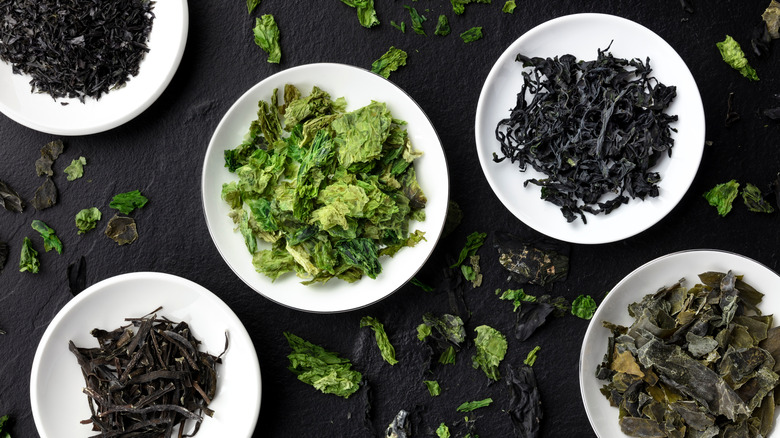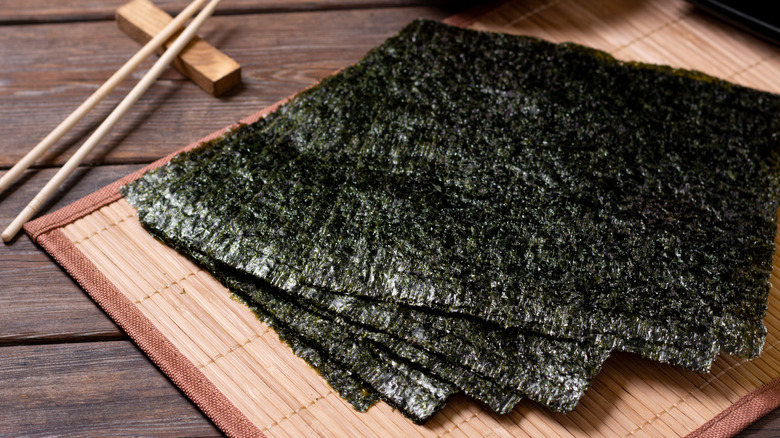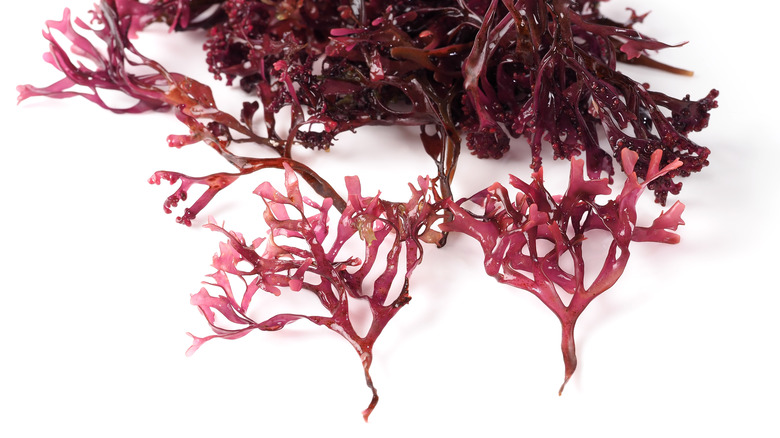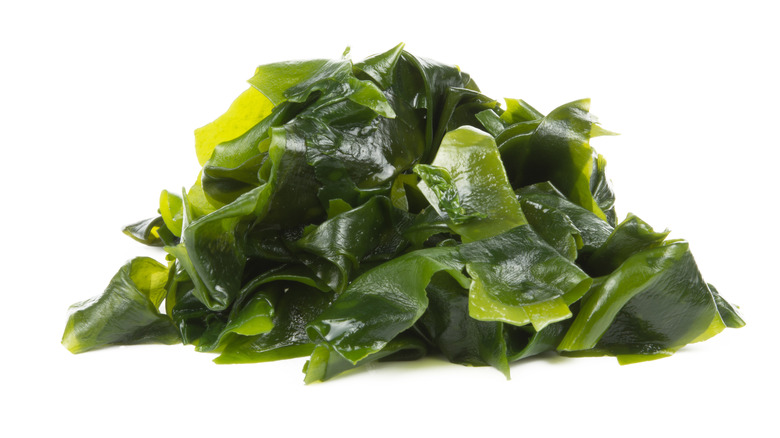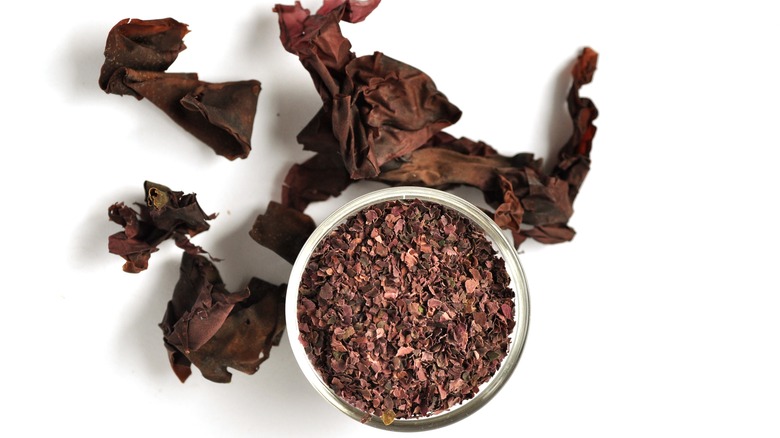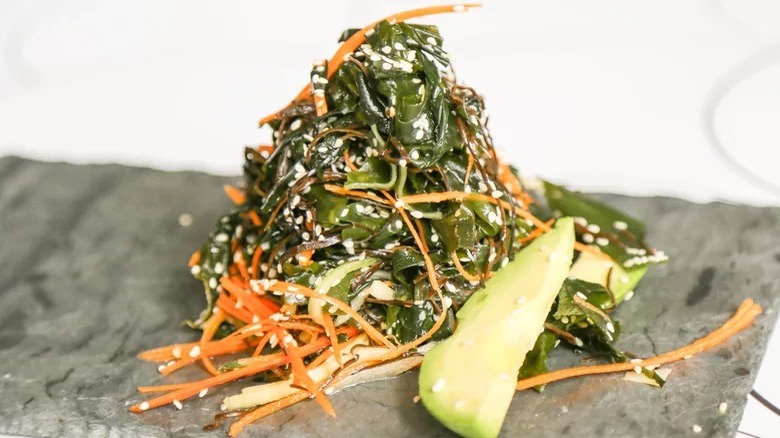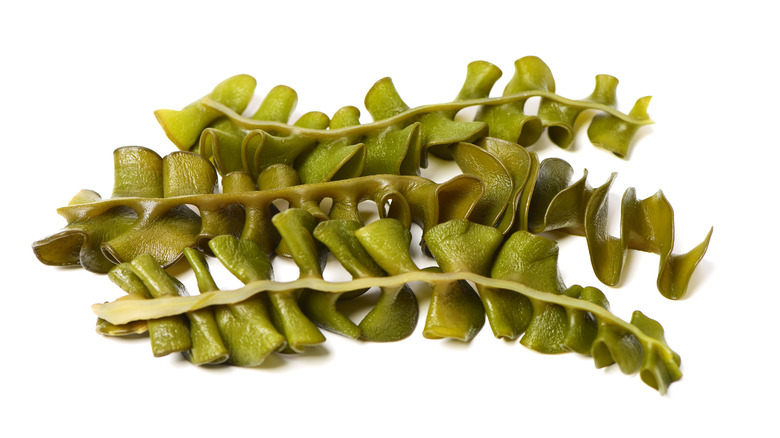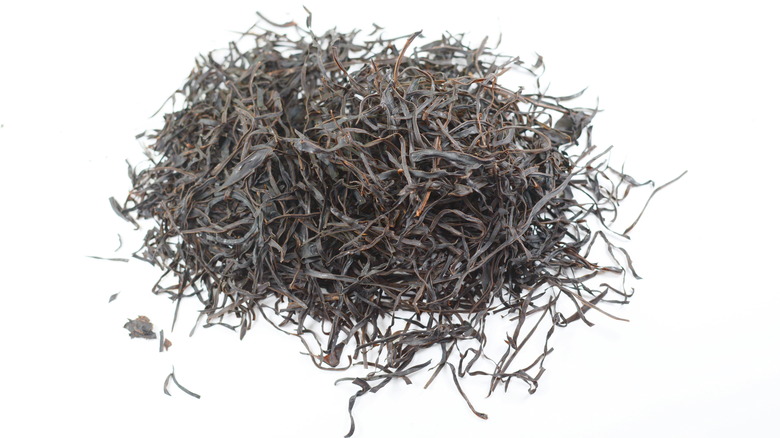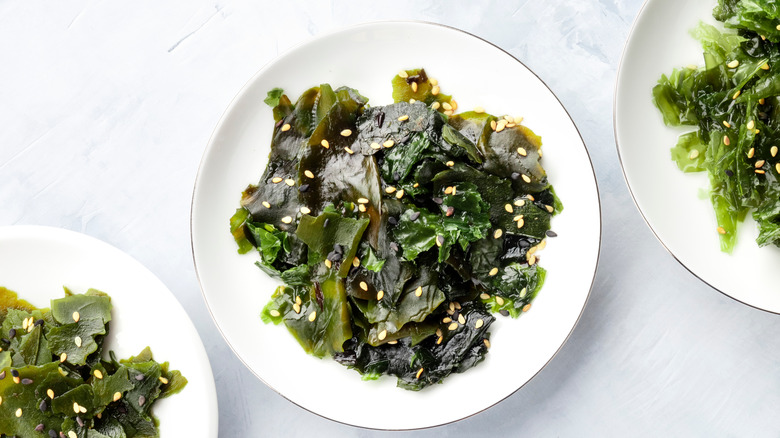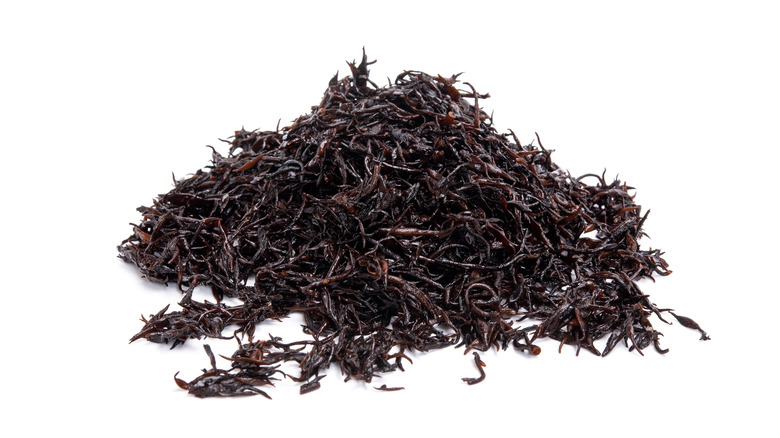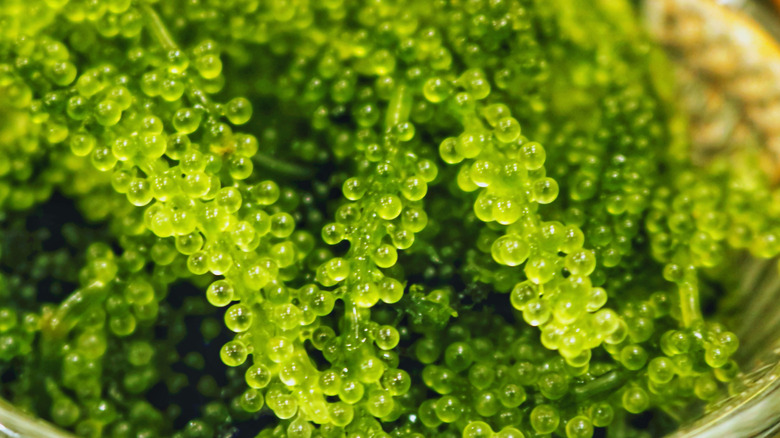10 Types Of Seaweed And How To Eat Them
While thousands of species of seaweed exist, only some are actually enjoyable to eat (via Seaweed). Seaweed is either going to be of the red, green, or brown algae variety, and though they're all different, the popular varieties often share a similarly salty, briny taste (which probably has something to do with the fact that they frequently grow in saltwater); therefore, when it comes to cooking with seaweed, all of the varieties are typically found in similar recipes, like soups, salads, and stir-frys.
All types of seaweed, like most vegetables, are packed with a variety of nutrients. WebMD explains the same nutrients and minerals that are typical of the leafy green veggies that we eat — like iron, iodine, magnesium, calcium, vitamins A and C, and folate — can be found in seaweed. These water-grown plants can support heart and gut health, cancer prevention, and overall good health.
While some seaweeds are easily accessible at most U.S. supermarkets, others might take a bit of searching to find, but we think they're worth the work. Here are 10 types of seaweed you should know.
Nori
We'll start off with an easy one. Even if you think you don't know nori, you do: it's the sushi seaweed. Nori is the thin, dark-colored seaweed that is wrapped around most variations of sushi rolls. According to Kitchn, it is made by "shredding edible seaweed and then pressing it into thin sheets." Since it's flaky and crispy, nori is also commonly eaten on its own as a healthy snack. Taste-wise, this seaweed is salty and often described as grassy.
Nori is a pretty versatile type of seaweed to cook with. You can crumble it finely as a salty topping on any dish, or use it as a wrap for sushi ingredients. Bon Appétit features a salad recipe that consists of pickled vegetables tossed in a nori vinaigrette. By finely blending the nori and combining it with soy sauce, oil, mirin, and rice vinegar, you'll have a tangy, briny dressing that works well for any salad.
Irish Moss
When you think of moss, you probably picture that vibrant green stuff that grows on trees and rocks. Irish moss, however, is a species of red algae and is thus red in color. As a plant, it sort of resembles a sea anemone, with long, spindly branches. Irish moss is well known for its health benefits, as it contains lots of carrageenan, which, according to WebMD, is a vegan gelatin substitute, as it also works well as an emulsifier.
Good Food Baddie refers to Irish moss, also known as sea moss, as a "superfood." Aside from its impressive, heart-healthy nutrition profile, which includes iodine, omega-3 fatty acids, and various antioxidants, according to WebMD, the blogger says that this weed is "mucilaginous (sticky and thick)," and can clear out phlegm and help with congestion.
As goes for most vegetables, it's important to thoroughly wash your sea moss before cooking with it. For their multi-purpose sea moss gel recipe, Good Food Baddie recommends soaking the sea moss (after cleaning it) for up to 24 hours.
Kombu
Kombu is one of the more well-known and widely used types of edible seaweed, and is jam-packed with health benefits. Sous Chef compares the kelp's taste to that of nori, stating that it may taste differently depending upon which region of Japan it's sourced from, but "generally Kombu it has a subtle, briny taste, extremely rich in umami."
If you've ever had miso soup, you have probably eaten kombu, as it's one of the main ingredients in Japanese dashi, which is commonly used as the broth in miso soup.
Since it's a vegetable with a full-bodied, savory umami flavor, kombu is incredibly popular in vegan and vegetarian dishes. It's fairly simple to cook with; simply throw it into any soup, or sauté it as you would other vegetables. Bon Appétit lists a mouthwatering array of kombu recipes, including classic miso soup and ramen. If you really want to tap into your culinary creativity, try making a salty seaweed butter to spread on crusty bread or on top of your favorite fish dishes.
Dulse
Dulse is similar to nori, in that it's flaky and salty. According to the Vegan Atlas, dulse is mostly grown off the northeastern coast of North America "from Maine to Newfoundland." They describe the flavor of dulse as "tangy, sharp-and-salty." The experts at MasterClass go so far to say that it tastes similar to bacon when crisped up in oil, making it an easy snack which is actually commonly served in Canadian pubs. Vegans can actually use the seaweed as a meat-free bacon substitute, like in this DLT (dulse, lettuce, and tomato) sandwich recipe from Food.
Dulse is sold at many grocery stores, and can be purchased as dry flakes, again, similar to nori. To cook with dulse, it's popular to sprinkle the salty flakes on top of soups, salads, or noodle dishes, and it can be ground into (or purchased as) a savory powder for seasoning. Notably, MasterClass states that Irish soda bread is often made with dulse!
Wakame
Even if the word wakame doesn't ring any bells, it's highly likely that you've come across this seaweed before. If you've ever had seaweed salad, it was probably made with stringy, slightly crunchy wakame.
Aside from its appealing texture and tangy, semi-sweet taste, wakame is incredibly nutrient-dense. According to Healthline, it is super low in calories, supports thyroid health, can help lower cholesterol, and can even aid in insulin resistance and lowering blood sugar.
When you buy wakame at the store, it typically comes in a dehydrated form, and for most recipes you'll want to rehydrate the plant by soaking it in water. MasterClass shares three common and versatile ways for cooking with wakame: sprinkled atop soup, on its own as a salad, or in sunomono. Sunomono is a popular Japanese salad that it is made with simple, fresh ingredients; has a salty, tangy flair; and is nutrient-dense while remaining light. In its recipe for the dish, Japanese Cooking 101 combines thinly sliced Persian cucumbers, rehydrated wakame, and a dressing made up of rice vinegar, soy sauce, sugar, salt, and sesame seeds.
Mekabu
If wakame is the leaf-looking part of the plant, Eden Foods explains mekabu is the part that attaches it to the earth — that is to say that mekabu is an edible part of the root of the wakame plant. Mekabu has a sort of spiral-y, ladder shape, so it's much more dense than the long, stringy branches of wakame.
According to a Japanese-Products, a blog that discusses different food products sold in Japan, mekabu is sold both dried and fresh in the country. When it comes to eating mekabu, the sticky ingredient is generally added to dishes like soups, salads, noodles, and rice. The seaweed is also seasoned and eaten on the side in small amounts (a serving is about one teaspoon), treated like a condiment, says Eden Foods.
Arame
Arame is a popular seaweed to include in recipes due to its high nutritional value and mildly sweet taste. Like kombu, arame is a type of kelp, characterized by long, frim brown strands that kind of resemble dried pasta. FitDay states that this kelp is packed with fiber, calcium, iron, iodine, magnesium, and vitamin A, making it beneficial for digestive, skeletal, and immune health.
Cooking with arame is fairly simple — all you have to do is soak it and then it can be sautéed like other veggies. Maša Ofei of Heartful Table shares a brown rice arame recipe that is nutrient dense and macrobiotic. Here, the seaweed is cooked with onions and carrots before being stirred into rice. Bon Appétit suggests including some arame in the mix next time you're cooking up some sautéed greens.
Sea Lettuce
Not to shock you, but sea lettuce looks a lot like regular lettuce. A bright green, leafy-looking plant with scalloped edges, sea lettuce is a super popular seaweed that is often eaten dried and crispy, added to soups and salads. According to Galloway Wild Foods, fresh sea lettuce is a bit bland, but once dehydrated the flavor is bold and concentrated, with a bitter note. While Galloway Food Finds makes note of the plant's protein content, Alive shares that it is packed with beneficial nutrients and fiber.
For salads, Maine Coast Sea Vegetables recommends either reconstituting the leaves or sourcing them raw. Dried, sea lettuce can be stirred into soups, used in its powdered form as a seasoning, or sprinkled atop dishes for a boost of briny flavor.
Hijiki
When dry, hijiki kind of looks like tea or a tiny vanilla bean — long, thin, and black in color. Food52 cheerfully calls it the "least seaweedy seaweed of all" due to its texture and earthy flavor.
Much like other forms of seaweed, hijiki can be used in stir-frys, salads, and soups, adding what Bon Appétit calls an "oceanic burst" to any dish it's included in. To cook with it, Food52 says to remember that "hijiki is more mushroom, less ocean: It wants to be with other earthy things." According to the outlet, it goes well with ingredients that balance this, like carrots and radishes, or ingredients with milder flavors, like rice. They offer Japan's hijiki no nimono as a classic dish featuring the seaweed, with features hijiki simmered in a mixture of sake, soy sauce, and mirin. The most difficult part about cooking with hijiki is that it needs to be rehydrated, which takes about 30 minutes, but simply consists of soaking the plant.
Umibudo
Umibudo, which translates to "sea grapes," has a distinct appearance that — get ready for this — resembles a bunch of green grapes or a string of beads. Texture-wise, Tsunagu Japan says this type of sea plant is often featured in ASMR videos because of its distinctly audible crunch.
Tsunagu Japan describes the flavor of umibudo as "fresh, ocean-like ... and is quite salty." It's common to eat umibudo as is, without cooking it; YouTuber TracyN ASMR dips their sea grapes in soy sauce mixed with wasabi, just like you'd do with sushi. If you'd like to throw an actual recipe together, umibudo is popular in salads due to its saltiness and crunch. The seaweed is often used as a topping in dishes or served as a side for added fresh flavor and a "textural contrast."
Like other seaweeds on our list, umibudo contains numerous health benefits, as it is rich in minerals like iron, calcium, and magnesium.
